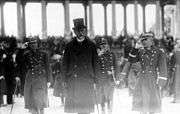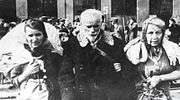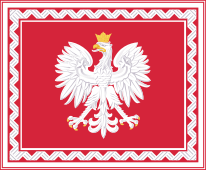Stanisław Wojciechowski
| Stanisław Wojciechowski | |
|---|---|
 | |
| President of Poland | |
|
In office 22 December 1922 – 14 May 1926 | |
| Prime Minister |
Władysław Sikorski Wincenty Witos Władysław Grabski Aleksander Skrzyński Wincenty Witos |
| Preceded by |
Gabriel Narutowicz Maciej Rataj (Acting) |
| Succeeded by |
Maciej Rataj (Acting) Ignacy Mościcki |
| Personal details | |
| Born |
15 March 1869 Kalisz, Poland |
| Died |
9 April 1953 (aged 84) Warsaw, Poland |
| Political party | Polish People's Party "Piast" |
| Spouse(s) | Maria Wojciechowska |
| Children | 2 |
| Signature |
|
Stanisław Wojciechowski (Polish: [staˈɲiswaf vɔjt͡ɕɛˈxɔfskʲi]; 15 March 1869 – 9 April 1953) was a Polish politician, scholar, and activist in the cooperative movement. In 1922 he was elected the second President of the Republic of Poland following the assassination of Gabriel Narutowicz. He was ousted by the May Coup d'État of 1926.[1]
While a student at the University of Warsaw, Wojciechowski worked for the Polish Socialist movement, which at the time was a major force in the Polish independence effort. He was arrested by czarist police in 1891, and again in 1892. Upon his release he moved to Zurich, then to Paris and finally to London. In England he helped publish the Polish Socialist periodical Przedświt (“The Dawn”). Active in the socialist movement, he often travelled undercover to Russian Poland, and became friends with Józef Piłsudski. He also studied the cooperative movement, and on returning to Poland legally in 1906 he spent time working to develop Polish cooperatives.
During World War I he considered Imperial Germany to be Poland’s main enemy. With the Russian evacuation in 1915, he moved to Moscow, and there in 1917 was elected president of the Council of Polish Parties’ Union. He returned to Warsaw after the October Revolution and from January 1919 to July 1920 served as minister of the interior in two separate cabinets of the new Second Polish Republic. When the Republic's president Gabriel Narutowicz was assassinated in December 1922, Wojciechowski was chosen to succeed him.
During his presidency, Wojciechowski and his erstwhile friend military chief of staff Piłsudski disagreed on the political direction of the nation: Wojciechowski supported continued parliamentary government, while Piłsudski favoured a more authoritarian approach. In May 1926, due to the worsening economic issues of the country, Piłsudski staged the successful May Coup, after which Wojciechowski resigned from his post.[2]
Biography
Early life
Stanisław Wojciechowski was born on 15 March 1869 in Kalisz into a Polish noble family with strong ties to the intelligentsia. He studied mathematics and physics at the University of Warsaw from 1888–1891. Wojciechowski was active during his studies, first in the conspiratorial organization "Zet", and later in the burgeoning socialist movement. By in 1892 he had abandoned his studies and chose the life of an exile after his second arrest and detention by the czarist police, first going to Zurich and then Paris. There he learned the trade of typesetter with which he supported himself. He was an 1892 co-founder of the Polish Socialist Party, who met in Paris and participated in the following year, on the first, illegally organized party conference in Vilnius, where he met Piłsudski. In 1893 after he was deported from France. He found his new center of life in London, where he worked as a typesetter, printer, journalist and publisher. He traveled several more times illegally to Congress Poland and the Russian Empire and smuggled printing machine components and publications into the country. Together with Piłsudski he formed the backbone of the socialist movement in Russian Poland. In 1899 he married Maria Wojciechowska.[3]
Political movements and career
After 1905 he left the Polish Socialist Party over disagreements on the political future of Poland and its relations to the international class struggle. After the amnesty in 1906, he returned to Warsaw and took part in the cooperative movement by Edward Abramowski. During World War I, Stanisław Wojciechowski, believed that Germany posed the biggest threat to Poland and thus decided to stay in Russia rather than side with his erstwhile friend Piłsudski. After the Russian evacuation of Congress Poland of 1915 he moved to Moscow where he remained active in Polish political circles. After the fall of the Tsarist regime was elected President of the Council of Polish Parties’ Union, and heavily engaged on behalf of the Polish Army in Russia in 1918. He was forced to leave Moscow under threat of arrest once the Bolshevik regime seized power. From 1919 to 1920, Wojciechowski served as Minister of the Interior for two consecutive Polish governments. During this time, Wojciechowski also participated in the drafting of the Polish constitution.[4]
Presidency
On 9 December 1922 he stood as a candidate in the presidential election, but was defeated in the fourth ballot to the landowner Count Maurycy Zamoyski and the later elected Gabriel Narutowicz. Following the assassination of President Narutowicz by the ultra-nationalist painter Eligiusz Niewiadomski on 16 December 1922, the candidacy waiver Piłsudski, who did not want to be blocked in a "gilded cage" according to his own words, Wojciechowski was, by the National Assembly on the recommendation of Sejm marshal Maciej Rataj with the votes of the Left and the Centre on the first ballot, elected head of state. Wojciechowski, who had been Minister of the Interior from 1919 to 1920, enjoyed great prestige among the workers and also in parts of the rural population.[5]
Wojciechowski's tenure was overshadowed by an increase in unemployment and inflation, by waves of strikes, financial scandals, numerous government crises and ultimately bloody riots in Kraków and other cities. 1923 Piłsudski resigned as army chief and chairman of the powerful military council. In November 1925 depicted the formation of a coalition government led by Aleksander Skrzyński is the last attempt to get at the serious economic problems of the country by parliamentary means.
Piłsudski's May Coup and resignation
After the May Coup, and the capture of Warsaw by Piłsudski's troops, President Wojciechowski was forced on the night of May 15, 1926, together with his government, to resign and to give the Marshal a free hand to initiate the "reorganization of the state". The president Ignacy Mościcki was installed as the new president. Following the resignation, Wojciechowski worked as a lecturer at the Warsaw School of Economics and the College of Agriculture in Warsaw. In 1937, he was the co-founder of the opposition Labour Party.
Death and legacy
Stanisław Wojciechowski retired to private life and survived the Second World War and the Warsaw Uprising (his son Edmund was a victim of Auschwitz). He died in Gołąbki (now Ursus) in 1953, at the age of 84.
Stanisław Wojciechowski experienced a political life not unlike that of many Central European politicians during the early 20th century. A radical in his youth, his ideology matured and grew more conservative with age. He was at the forefront of over a quarter-century of Polish political development and is considered one of the founders of the modern independent Polish state.
Gallery


.jpg)


.jpg)

See also
References
| Wikimedia Commons has media related to Stanisław Wojciechowski. |
- ↑ "Stanislaw Wojciechowski (president of Poland)". Encyclopædia Britannica.
- ↑ Zygmunt Kaczmarek, Trzej prezydenci II Rzeczypospolitej (Warszawa: Instytut Wydawniczy Związków Zawodowych, 1988), p. 167
- ↑ Stanisław Wojciechowski, "Moje wspomnienia" (Warszawa–Lwów: Książnica-Atlas, 1938), p. 53–55, 130
- ↑ Zygmunt Kaczmarek, Trzej prezydenci II Rzeczypospolitej (Warszawa: Instytut Wydawniczy Związków Zawodowych, 1988), p. 114–119
- ↑ http://memim.com/stanislaw-wojciechowski.html
- Stanisław Wojciechowski. Kancelaria Prezydenta RP. President of the Republic of Poland. 1 December 2005
- Polish President: a Co-operator The Co-operative League of USACo-operation IX 1923: 67.
- Stanislaw Wojciechowski Encyclopædia Britannica. 2005. Encyclopædia Britannica Premium Service. 1 December 2005
| Political offices | ||
|---|---|---|
| Preceded by Maciej Rataj |
President of Poland 1922–1926 |
Succeeded by Maciej Rataj |
